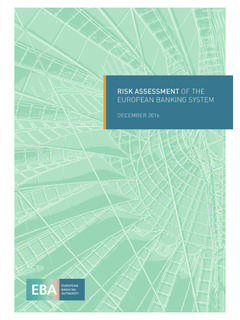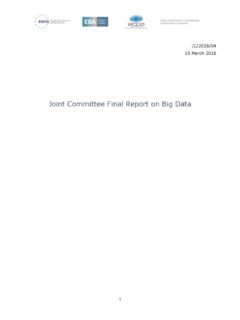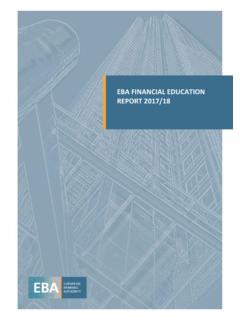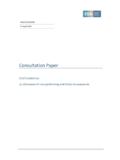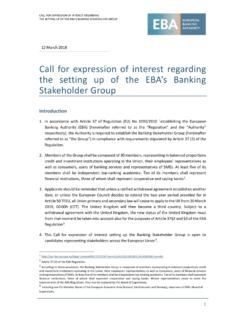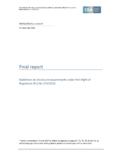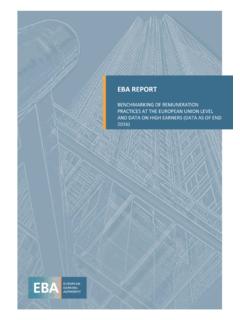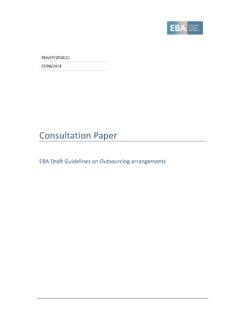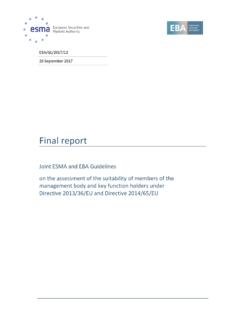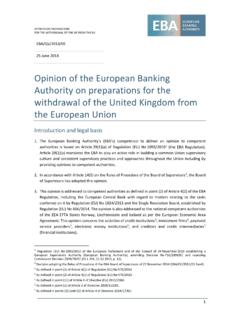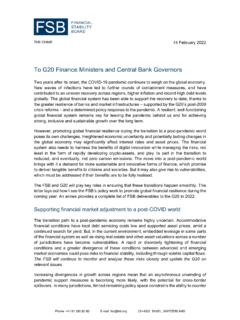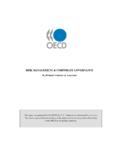Transcription of Final Report - eba.europa.eu
1 EBA/GL/2021/11. 09/11/2021. Final Report Guidelines on recovery plan indicators under Article 9 of Directive 2014/59/EU. GUIDELINES ON RECOVERY PLAN INDICATORS. Contents Executive summary 3. Next steps 4. Background and rationale 5. Changes to the minimum list of recovery plan indicators 5. Additional guidance on the calibration of recovery plan indicator thresholds 6. Additional guidance on breaching and monitoring of recovery plan indicators 8. Guidelines 10. 1. Compliance and reporting obligations 11. 2. Subject matter, scope and definitions 12. Scope of application 12. Addressees 12. Definitions 13. 3. Implementation 13. Date of application 13. Repeal 13. 4. Setting the framework of recovery plan indicators 14. Categories of recovery plan indicators 14. Requirements for the calibration of recovery plan indicators 15.
2 Actions and notifications upon breaching an indicator 17. Arrangements for monitoring recovery plan indicators 18. 5. Recovery plan indicators 18. Liquidity indicators 19. Profitability indicators 20. Asset quality indicators 20. Market-based indicators 20. Macroeconomic indicators 21. 6. Accompanying documents 25. Cost-benefit analysis / impact assessment 25. Feedback on the public consultation 30. 2. GUIDELINES ON RECOVERY PLAN INDICATORS. Executive summary Directive 2014/59/EU (BRRD) establishes recovery plans as an important component of the European recovery and resolution framework and essential to ensuring proper crisis preparedness. The role of recovery plans is to ensure that credit institutions and investment firms consider in advance which corrective actions they could effectively take in situations of stress to restore their financial and business viability.
3 In accordance with Article 9(1) of the BRRD, a recovery plan should include a framework of indicators established by each institution with the aim of identifying the points at which the escalation process should be activated and to assess what appropriate actions referred to in the recovery plan may be taken. Recovery plan indicators are a core element of recovery plans. Their main objective is to identify a stressed or crisis situation at an early stage in order to prevent undue delays in the implementation of recovery measures and enable institutions to undertake efficient, timely and effective actions to address it. Under the mandate of Article 9(2) of the BRRD, in 2015 the EBA issued guidelines to specify the minimum list of quantitative and qualitative indicators for the purposes of recovery planning (EBA- GL-2015-02).
4 They have established a common EU standard for developing the framework of recovery plan indicators, while leaving some constrained flexibility to tailor a set of recovery plan indicators depending on institutions' specificities. The guidelines recognise that each institution should include both qualitative and quantitative indicators which are the most relevant when developing its recovery plan. Moving from this premise, the guidelines provide the requirements that institutions should meet when developing the framework for recovery plan indicators, and specify the minimum list of categories that should be included in all recovery plans. For each category of recovery plan indicators, the guidelines spell out specific indicators that should be included unless the institution justifies to the competent authorities that they are not relevant to its legal structure, risk profile, size and/or complexity ( a rebuttable presumption).
5 Finally, the guidelines recognise that institutions should not limit their set of indicators to the minimum list. Since the development of the guidelines in 2015, significant practical experience in developing and assessing recovery plans has been acquired. Moreover, in 2020 the EBA conducted a survey among competent authorities on the performance of recovery plan indicators in the context of the Covid- 19 outbreak and previous idiosyncratic crises. Against this background, the EBA has concluded that, while only limited amendments to its existing guidelines are needed, it is necessary to introduce additional guidance on certain parts of the recovery plan indicator framework. This approach has the advantage of maintaining overall stability in the recovery plan indicator framework while focusing on the areas in which practical experience showed a need for additional clarification and guidance.
6 Most of the provisions of the existing guidelines remain unaltered apart from replacing or adding a few metrics to the minimum list of recovery plan indicators and updating the format of the existing 3. GUIDELINES ON RECOVERY PLAN INDICATORS. text to the current legal template for EBA guidelines. In the proposed revision, the existing guidelines have been expanded in the following areas: i. Calibration of recovery plan indicators additional guidance is provided to institutions on the general principles to follow in setting the thresholds of recovery plan indicators, focusing also on the treatment of recovery plan indicators in a crisis, in particular in the case of the application of supervisory relief measures. On the latter point, the guidelines clarify that, in the case of a systemic crisis, there should not be automatic recalibration of recovery plan indicators due to supervisory relief measures unless in duly justified cases and agreed with the competent authority; and ii.
7 Actions and notifications upon a recovery plan indicator breach and monitoring of recovery plan indicators the guidelines recognise the importance of timely notification of recovery plan indicator breaches and of frequent monitoring of indicators in a situation of crisis for the institution and the competent authority. Next steps The guidelines on recovery plan indicators will apply from The 2015 guidelines on recovery plan indicators will be repealed at the same time. 4. GUIDELINES ON RECOVERY PLAN INDICATORS. Background and rationale 1. The BRRD requires credit institutions and investment firms to plan to strengthen their ability to restore financial and economic viability when they fall into situations of stress. Through recovery planning, institutions are preparing in advance to address a wide range of crises that could emerge.
8 Recovery plan indicators are a key component of recovery plans and their main objective is to help the institution to monitor and respond to the emergence and evolution of a stress situation. In order for this signalling mechanism to work, it needs to be set properly. The risk of a weak indicator framework is that the effectiveness of the institution's recovery options could be compromised by their implementation at the wrong time. 2. These guidelines have been developed on the basis of the legal mandate included in Article 9(2). of the BRRD in order to provide to institutions and competent authorities in a single set of guidelines the essential elements to be followed when developing the recovery plan indicator framework. 3. The guidelines specify the minimum list of categories of recovery plan indicators that should be covered (capital, liquidity, profitability and asset quality indicators) plus two other categories (market-based and macroeconomic indicators) to be included unless the institution justifies to the competent authorities that they are not relevant to its legal structure, risk profile, size and/or complexity ( a rebuttable presumption).
9 4. For each category, the guidelines provide a list of specific recovery plan indicators to be included unless the institution can justify to the competent authorities why they are not relevant to its legal structure, risk profile, size and/or complexity ( a rebuttable presumption). This rule is applicable without prejudice to the application of simplified obligations for recovery planning. The guidelines also encourage institutions to include additional recovery plan indicators (not included in the minimum list) depending on their business and risk profile. For this reason, the guidelines include an exemplary list with additional recovery plan indicators broken down by categories. Changes to the minimum list of recovery plan indicators 5. The minimum list of indicators established in EBA-GL-2015-02 has been reviewed, taking into account relevant policy developments and practical experience in their application since 2015.
10 On this basis, limited amendments have been introduced by adding three recovery plan indicators and removing one indicator from the minimum list. Indicators added to the minimum list: i. MREL ( the minimum requirement for own funds and eligible liabilities set for institutions pursuant to the BRRD) and TLAC ( the Total Loss Absorbing Capacity) . MREL and TLAC are important regulatory requirements and fundamental to ensuring 5. GUIDELINES ON RECOVERY PLAN INDICATORS. resolvability of institutions. Since the issuance of the guidelines in 2015, binding MREL. intermediate and Final targets have been set for all institutions to which they apply. G- SIIs must comply with TLAC targets. ii. Available central-bank eligible unencumbered assets recent experience with crisis situations has highlighted the usefulness of asset encumbrance as a liquidity indicator.
